Top speed 222 km/h Length 6.38 m | Wingspan 8.11 m Range 483 km First flight November 22, 1916 | |
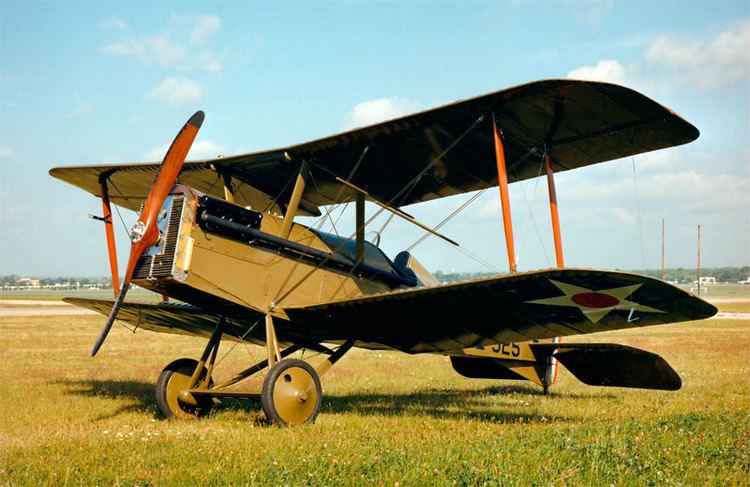 | ||
Manufacturers Wolseley Motors, Vickers, Austin Motor Company | ||
Royal aircraft factory s e 5a wwi fighter
The Royal Aircraft Factory S.E.5 was a British biplane fighter aircraft of the First World War. It was developed by the Royal Aircraft Factory by a team consisting of Henry Folland, John Kenworthy and Major Frank Goodden. It was one of the fastest aircraft of the war, while being both stable and relatively manoeuvrable. According to aviation author Robert Jackson, the S.E.5 was: "the nimble fighter that has since been described as the 'Spitfire of World War One'".
Contents
- Royal aircraft factory s e 5a wwi fighter
- Tribute to the royal aircraft factory s e 5a
- Origins
- SE5a
- SE5b
- Design
- Operational history
- Variants
- Operators
- Originals
- Reproductions
- Fictional portrayals
- Specifications SE5a
- References

The S.E.5 was capable of superior overall performance than the rival Sopwith Camel, both aircraft being capable dogfighters of the era; however, problems with its Hispano-Suiza engine, particularly the geared-output H-S 8B-powered early versions, meant that there was a chronic shortage of S.E.5s until well into 1918. Thus, while the first examples had reached the Western Front before Camel, there were fewer squadrons were equipped with the S.E.5 than those that had been provided with the Sopwith fighter instead.
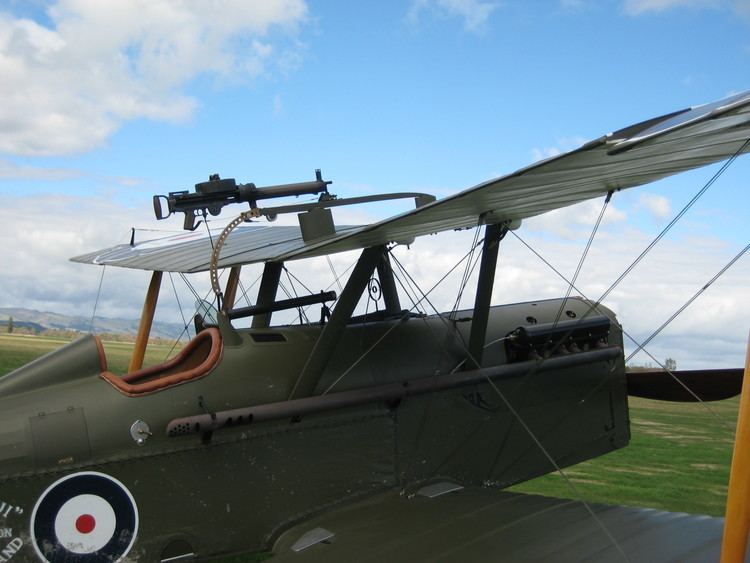
Together with the Camel, the S.E.5 was instrumental in regaining allied air superiority in mid-1917 and maintaining it for the rest of the war, ensuring there was no repetition of "Bloody April" 1917 when losses in the Royal Flying Corps were much heavier than in the Luftstreitkräfte. The S.E.5s remained in RAF service for some time following the Armistice that ended the conflict, but began to be withdrawn soon afterwards. Quantities of ex-RAF aircraft were transferred to various overseas military operators, a number were also adopted by civilian operators.
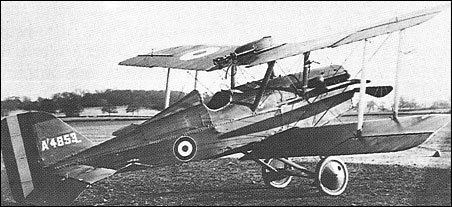
Tribute to the royal aircraft factory s e 5a
Origins
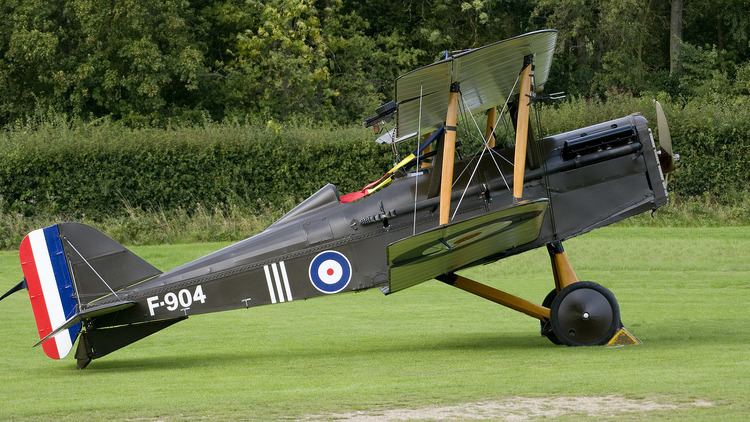
The S.E.5 (Scout Experimental 5) was designed by Henry Folland, John Kenworthy and Major Frank Goodden of the Royal Aircraft Factory in Farnborough. It was built around the new 150 hp (112 kW) Hispano-Suiza 8 a V8 engine that, while providing excellent performance, was initially underdeveloped and unreliable. The first of three prototypes flew on 22 November 1916. The first two prototypes were lost in crashes (the first killing the chief test pilot at the Royal Aircraft Factory, Major F. W. Goodden on 28 January 1917) due to a weakness in their wing design. The third prototype underwent modification before production commenced; the S.E.5 was known in service as an exceptionally strong aircraft which could be dived at very high speed – the squarer wings also gave much improved lateral control at low airspeeds.
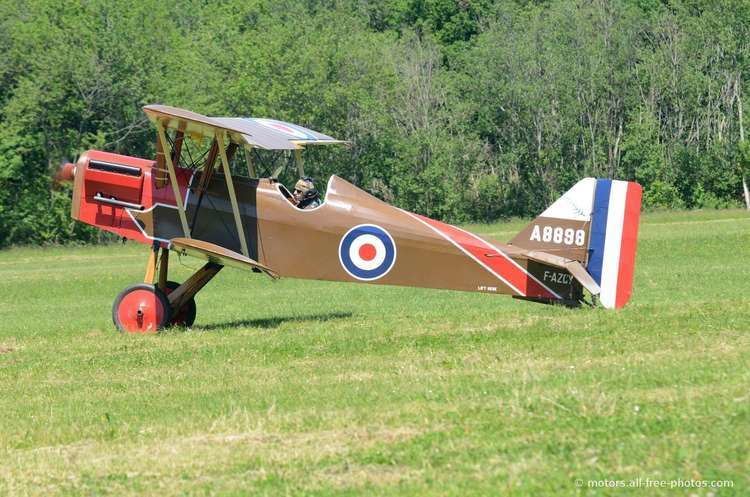
Like the other significant Royal Aircraft Factory aircraft of the war (B.E.2, F.E.2 and R.E.8) the S.E.5 was inherently stable, making it an excellent gunnery platform, but it was also quite manoeverable. It was one of the fastest aircraft of the war at 138 mph (222 km/h), equal at least in speed to the SPAD S.XIII and faster than any standard German type of the period. While the S.E.5 was not as agile and effective in a tight dogfight as the Camel it was much easier and safer to fly, particularly for novice pilots. According to "Dodge" Bailey, Chief Test Pilot of the Shuttleworth Collection, it had "somewhat similar handling characteristics to a de Havilland Tiger Moth, but with better excess power".
S.E.5a
Only 77 original S.E.5 aircraft had been completed prior to production settling upon an improved model, designated as the S.E.5a. The initial models of the S.E.5a differed from late production examples of the S.E.5 only in the type of engine installed – a geared 200 hp Hispano-Suiza 8b, often turning a large clockwise-rotation four-bladed propeller, replacing the 150 hp H.S. 8A model. In total 5,265 S.E.5s were constructed by six manufacturers: Austin Motors (1,650), Air Navigation and Engineering Company (560), Curtiss (1), Martinsyde (258), the Royal Aircraft Factory (200), Vickers (2,164) and Wolseley Motors Limited (431).
Shortly following the American entry into World War I, plans were mooted for several American aircraft manufacturers to commence mass production of aircraft already in serve with the Allied powers, one such fighter being the S.E.5. In addition to a smaller order of 38 of Austin-built S.E.5a aircraft which were produced in Britain and assigned to the American Expeditionary Force to equip already-deployed US Army squadrons, the US Government issued multiple order to the Curtiss Aeroplane and Motor Company for the manufacture and delivery of a large quantity of S.E.5s, reportedly around 1,000 aircraft, to be produced in the United States. However, out of the Curtiss-built aircraft, only one fighter would be completed prior to the end of the conflict, after which the demand for the S.E.5 had effectively evaporated and production being quickly halted after a further 56 aircraft were assembled for already-delivered components.
At first, airframe construction outstripped the very limited supply of French-built Hispano-Suiza engines and squadrons earmarked to receive the new fighter had to soldier on with Airco DH 5s and Nieuport 24s until early 1918. The troublesome geared "-8b" model was prone to have serious gear reduction system problems, sometimes with the propeller (and even the entire gearbox on a very few occasions) separating from the engine and airframe in flight, a problem shared with the similarly-powered Sopwith Dolphin. The introduction of the 200 hp (149 kW) Wolseley Viper, a high-compression, direct-drive version of the Hispano-Suiza 8a made under licence by Wolseley Motors Limited, solved the S.E.5a's engine problems and was promptly adopted as the type's standard powerplant. A number of aircraft were subsequently converted to a two-seat configuration in order to serve as trainer aircraft.
S.E.5b
The S.E.5b was a variant of the S.E.5 with a streamlined nose and upper and lower wings of different span and chord. The single example, a converted S.E.5a, first flew in early April 1918. It had a spinner on the propeller and a retractable underslung radiator. The S.E.5b was not a true sesquiplane – as the lower wing had two spars. Its performance was little better than the S.E.5a – the increased drag from the large upper wing seems to have cancelled out any benefit from the better streamlined nose. The S.E.5b was not considered for production; probably it was always intended mainly as a research aeroplane. In January 1919, it was tested with standard S.E.5a wings and in this form survived as a research aircraft into the early twenties.
Design
The Royal Aircraft Factory S.E.5 was a British biplane fighter aircraft. In spite of possessing a square-and-boxy appearance, it was an advanced aircraft for the era; amongst its features, the S.E.5 was the first aircraft to be equipped with a pilot-adjustable tail-plane and a steerable tailskid. The S.E.5 was composed of a wire-braced box girder structure while the wings were furnished with wooden spars and internal ribs. The fuselage was narrower than many contemporary aircraft, which provided the pilot with good all-round visibility. Reportedly, the aircraft had considerable structural strength, which was credited with improving the type's crashworthiness and survivability. It could also withstand high-g manoeuvres and was relatively resistant to battle-damage.
Unlike many of its peers, which were unforgiving and highly agile, the S.E.5 was comparably stable, easy to fly and forgiving; its stability enabling pilots to more readily fire upon enemies from further away with a greater degree of accuracy. It had a noticeably lower accident rate than comparable aircraft. The cockpit was set amidships, making it difficult to see over the long front fuselage, but otherwise visibility was good. Perhaps its greatest advantage over the Camel was its superior performance at altitude, making it a much better match for the Fokker D.VII when that fighter arrived at the front. Aviation authors Donald Nijboer and Dan Patterson attribute the S.E.5 as being "arguably the best British-built fighter of World War I".
The S.E.5 was powered by various engines, initially adopting a Hispano-Suiza 8 V8 engine. The Hispano-Suiza engine was relatively advanced for the era, featuring various advanced technologies such as an aluminum cylinder block with steel liners, dual ignition and forced lubrication that aided cooling; it also had the advantage of being easy to operate by most pilots. An expansion tank for the cooling system was integrated into the leading edge of the wing's center section. Reportedly, the S.E.5 was relatively easy to fly, albeit with the exception of an adverse yaw tendency that was generated was the rotation of the operating engine engine. The yaw can be compensated for by balanced application of the aileron and rudder. Furthermore, by appropriately adjusting the elevator trim, it can become possible for the SE5 to be flown in a 'hands off' manner.
The S.E.5 was armed with a single synchronised .303-inch Vickers machine gun in contrast to the Camel's two, but it also had a wing-mounted Lewis gun fitted on a Foster mounting, which enabled the pilot to fire at an enemy aircraft from below in addition to the forward-firing gun. This armament configuration was much appreciated by the pilots of the first S.E.5 squadrons as the new hydraulic-link "C.C." synchronising gear for the Vickers machine gun was unreliable at first. The Vickers gun was mounted on the forward left dorsal surface of the fuselage with the breech inside the cockpit, at a slight upwards angle. Typically, spare magazines for the Lewis gun would have been placed within most of the free space in the cockpit including the forward areas, such as the instrumentation panel.
Various instruments were typically provided, including a compass, altimeter, tachometer, oil pressure indicator, airspeed gauge, radiator temperature dial, fuel air pressure indicator, fuel selector, and air exchange; these were somewhat difficult to view due to their low-set position in the cockpit. According to "Dodge" Bailey, Chief Test Pilot of the Shuttleworth Collection, the S.E.5's cockpit was "the best of the bunch from the era". Individual in-service S.E.5s would often receive customisations and user-specified tweaks at the request of their pilots. Popular changes included reducing the dihedral of the wings in order to increase its manoeuvrability and the removal of the head faring to increase the pilot's visibility to the rear. James McCudden, an ace pilot, was famous for his prolific fine-tuning of his aircraft in order to produce improved performance from it; McCudden was able to increase the top speed by 9 MPH and to raise the service ceiling from the standard 17,000ft to 20,000ft through adaptions made.
Operational history
In March 1917, the S.E.5 entered service with No. 56 Squadron RFC, although the squadron did not deploy to the Western Front until the following month. Everyone was suspicious of the large "greenhouse" windscreens fitted to the first production models. These were designed to protect the pilot in his unusually high seating position, which was in turn intended to improve vision over the upper wing. The squadron did not fly its first patrol with the S.E.5 until 22 April, by which time, on the insistence of Major Blomfield, 56 squadron's commanding officer, all aircraft had been fitted with small rectangular screens of conventional design. The problem of the high seating position was solved by simply lowering it, pilots in any case preferring a more conventional (and comfortable) seating position. No complaints seem to have been made about the view from the cockpit, in fact this was often cited as one of the strong points of the type.
While pilots, some of whom were initially disappointed with the S.E.5, quickly came to appreciate its strength and fine flying qualities, it was popularly judged to have been underpowered; this failing was addressed by the introduction of the more powerful S.E.5a. In June 1917, the S.E.5a entered service and quickly began to replace the S.E.5. At this time 56 Squadron was still the only unit flying the new fighter; in fact it was the only operational unit to be fully equipped with the initial 150 hp S.E.5 – all other S.E.5 squadrons officially used the 200 hp S.E.5a from the outset – although a few S.E.5s were issued to other squadrons due to an acute shortage of the S.E.5a. Deliveries of the S.E.5a suffered from delays due to a shortage of available engines with which to power the type.
Due to the shortage of aircraft, there was a very slow initial buildup of new S.E.5a squadrons, which lasted well into 1918. Once the Wolseley Viper-powered model became plentiful, many more units were re-equipped with the type. By the end of the war, the S.E.5a was employed by a total of 21 British Empire squadrons as well as two U.S. units. Many of the top Allied aces of the Great War flew this fighter, including Billy Bishop, Andrew Beauchamp-Proctor, Edward Mannock and James McCudden. Legendary British ace Albert Ball was initially disparaging of the S.E.5, but in the end claimed 11 of his 44 victories flying it. McCudden wrote of the S.E.5: "It was very fine to be in a machine that was faster than the Huns, and to know that one could run away just as things got too hot."
Sholto Douglas who commanded No. 84 Squadron RFC which was initially equipped with the S.E.5a, listed the type's qualities as being: "Comfortable, with a good all-round view, retaining its performance and manoeuvrability at high level, steady and quick to gather speed in the dive, capable of a very fine zoom, useful in both offence and defence, strong in design and construction, [and] possessing a reliable engine".
While the S.E.5 remained in RAF service after the Armistice, the type began to be withdrawn soon afterwards. The S.E.5 also continued in service for a time in Australia and Canada, and in 1921 a Viper-engined S.E.5a was taken to Japan by the British Aviation Mission to the Imperial Japanese Navy.
A number of machines found roles in civilian flying after the war. On 30 May 1922, the first use of skywriting for advertising occurred when Cyril Turner, a former RAF officer, spelt out "London Daily Mail" in black smoke from an S.E.5a at the Epsom Derby. Others were used for air racing; one such privately owned aircraft won the Morris Cup race in 1927.
Variants
Operators
Originals
An original S.E.5a may be seen at the Shuttleworth Collection at Old Warden, England, UK. This aircraft was originally serial F904 of No. 84 Squadron RAF, then flew as G-EBIA from September 1923 to February 1932. It was stored between 1933 and 1955, before being restored to a flightworthy condition by staff at the Royal Aircraft Establishment and then passed onto the Shuttleworth Collection. An extensive refurbishment of this aircraft was performed in 2007. It has been re-registered as G-EBIA, it was first painted as D7000, then as F904.
An original S.E.5e may be seen in the National Museum of the United States Air Force at Dayton, Ohio, USA. The museum acquired the S.E.5e through a donation by the estate of Lt. Col. William C. Lambert, USAF Ret,. a First World War ace with 21.5 victories. Lambert flew the S.E.5a as an American member of the Royal Flying Corps and the Royal Air Force. The Air Force Museum Foundation also helped buy the aircraft. It is painted to represent an S.E.5e of the 18th Headquarters Squadron, Bolling Field, Washington, D.C., in 1925.
Another four original airframes are statically displayed at: the Science Museum, London, UK; Royal Air Force Museum, London, UK; South African National Museum of Military History, Johannesburg, South Africa; and the Australian War Memorial, Canberra, Australia.
Reproductions
Two full-scale replica S.E.5a aircraft were built by Miles Aircraft in 1965 for use in film making and were transferred to the Irish civil aircraft register in 1967 while the two were employed in flying scenes for the 1966 war movie The Blue Max. Both were destroyed in crashes in Ireland during 1970.
Three flightworthy reproductions (designated SE5a-1), along with a single static example, were constructed by The Vintage Aviator Limited in New Zealand. According to the group, the reproduction aircraft, which was the company's first project combined original archived drawings along with some authentic component components such as the Hispano engines used, while modern technology was used to fabricate many of the components used. These three SE5a-1s currently fly from Hood Aerodrome, Masterton.
Another SE5a project was started in the UK in the 1980s by John Tetley and "Bill" Sneesby. This machine was rebuilt around a number of original components believed to be from G-EAXW (F5259). The original drawings were referred to throughout the rebuild. In 1995, the aircraft was transferred to The Memorial Flight (based at La Ferte Alais, in France) to be completed and flown. The restoration was completed and the aircraft was painted in the colours of Lt. H. J. "Hank" Burden of 56 Squadron as of April 1918. The aircraft has since returned from France and is stored at an unknown location in the U.K.
A full-scale reproduction, finished in the colors of F8010, one of the 38 Austin Motor Company-built S.E. 5as given to the U.S. Army Air Service as the last S.E.5a flown by Lt. Joseph E. "Child Yank" Boudwin (a former wingman of 84 Squadron RAF's ace pilot Andrew Beauchamp-Proctor), while serving with the USAS' 25th Aero Squadron during the last week of active air combat before the Armistice, is on static display at the Old Rhinebeck Aerodrome in Rhinebeck, New York, built by volunteers from the Intrepid Sea, Air & Space Museum in New York City. This volunteer group consisted of veteran WWII pilots and was headed by Mr Doug Douglas. The Intrepid Sea Air and Space Museum donated the SE5a to the Rhinebeck Aerodrome Museum in 2000.
The Seattle Museum of Flight displays the reproduction SE.5a that Florida craftsman Bobby Strahlman and his partners completed for collector Doug Champlin in 1989. This reproduction featured a single .303 Vickers and one .303-caliber Lewis machine gun, it also carries the paint scheme of American ace George Vaughn, who served with the Royal Flying Corps. The SE.5 was displayed at Champlin's fighter museum at Mesa, Arizona until the collection was transferred to Seattle in 2003.
Fictional portrayals
The Royal Aircraft Factory S.E.5 has been portrayed, both by original and replica aircraft, in various movies. These include Wings (1927), Hell's Angels (1930), Flying Down to Rio (1933), Crimson Romance (1934), Test Pilot (1939) and The Aviator (2004).
The 1971 film Zeppelin makes reference to the use of the S.E. 5 as a weapon to defend against the German Zeppelins that were attacking Britain during the First World War. The film, however, is set in the fall of 1915, a full year-and-a-half before the S.E. 5 entered squadron service. The dogfight scene near the film's conclusion features S.E. 5a replicas.
Specifications (S.E.5a)
Data from South African National Museum of Military History The Vintage Aviator
General characteristics
Performance
Armament
